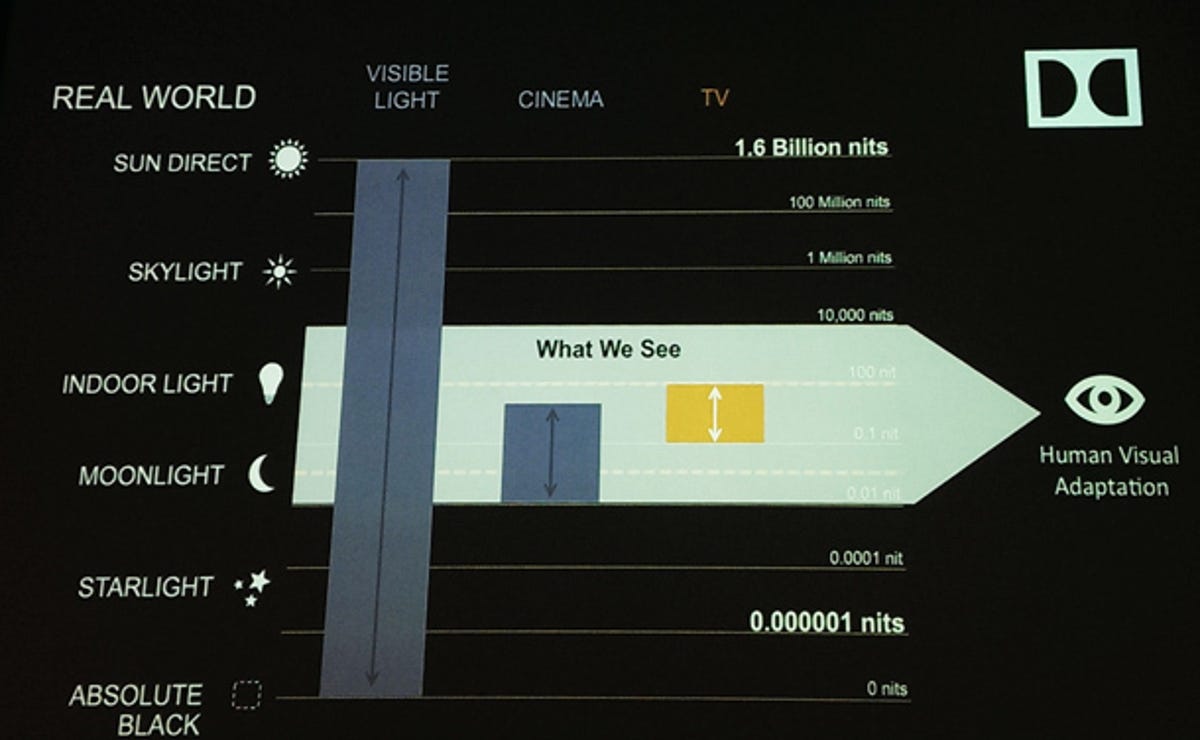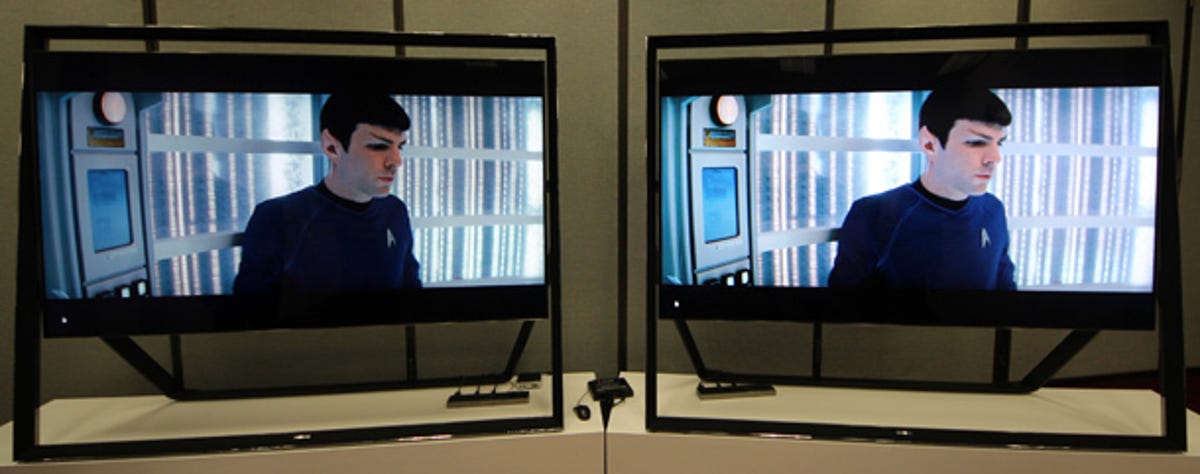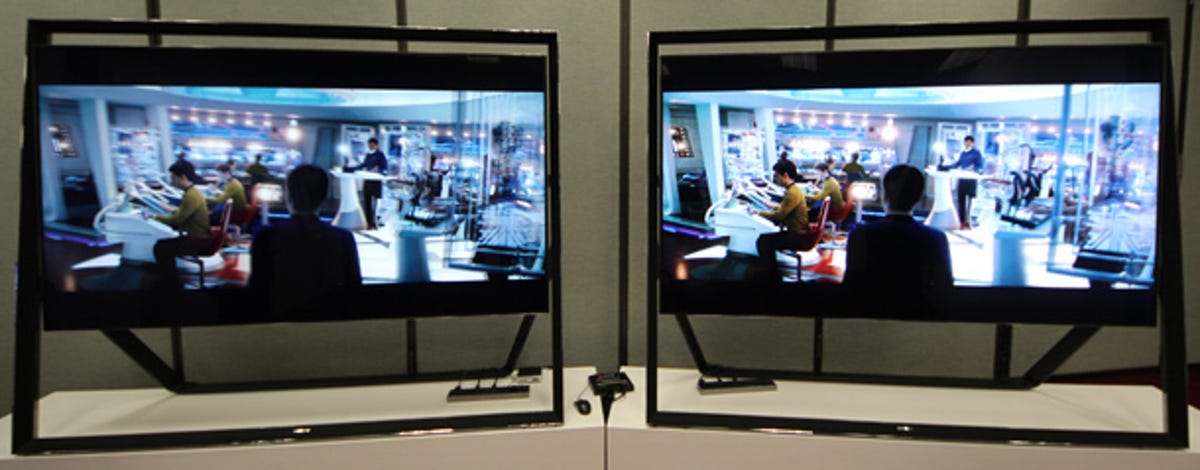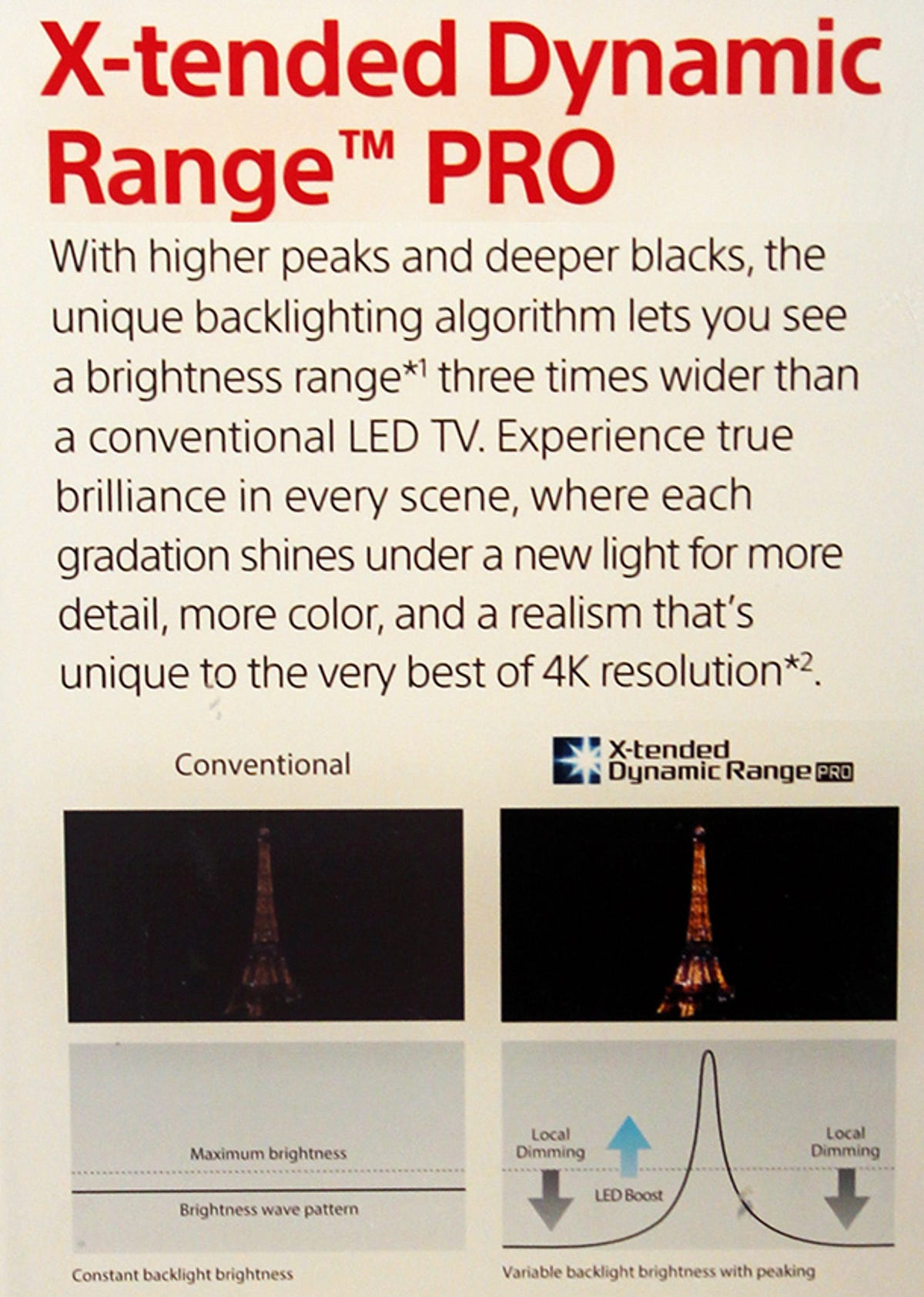
Dolby
Dynamic range: the spread between the darkest and the brightest a TV can be. In other words, contrast ratio. But having beaten that term into the ground with a decade of dubious marketing use, it was time for new terminology.
Except, this isn’t just marketing fluff. High dynamic range, in its multiple forms, can be a significant and noticeable increase in picture quality. Multiple companies are talking about it, from Dolby and its Vision tech, to Sony, Samsung, and others.
While 4K, curved, and OLED get lots of attention, it’s possible HDR will improve not only LCDs, but other technologies too.
First, a quick primer of what we’re talking about. Contrast ratio is a number that represents the difference between the darkest image a TV can produce, and the brightest. So a TV that can create a 100 foot-Lambert (a measure of brightness) bright white image, and a 0.01 ftL dark image, is said to have a contrast ratio, or a dynamic range of 10,000:1. A TV capable of 50 ftL and 0.05 ftL would have a contrast ratio of 1,000:1.
The problem is, there is no regulation on how to measure contrast ratio, so manufacturers are free to be…creative in their numbers. Generally speaking, LCDs have a native contrast ratio of between 2,000 and 4,000, plasmas can be two to three times that, and OLED is effectively infinite because the blacks are as close to no light as possible.
For the full story, check out “Contrast ratio (or how every TV manufacturer lies to you).”
High dynamic range
Expanding contrast ratio, or the dynamic range of the TV, is vital in creating a realistic image. A low-contrast image looks washed out and flat; a high-contrast image looks 3D (even if it’s 2D) with depth and realism. While I can’t force the monitor on which you’re reading this article to mimic a high contrast ratio screen, this is roughly what the two would look like side-by-side:


Geoffrey Morrison/CNET
One of the most vocal proponents of HDR right now is Dolby. Dolby Vision is not just TV tech, but a content and distribution method that aims to increase the dynamic range of the signal and the TV. Together, these two things could result in a much more realistic picture.
Here’s a slide from its preshow tech demo that shows what its idea is.


Geoffrey Morrison/CNET
For the full story, check out “Behind the scenes with Dolby’s new HDR TV tech.”
Dolby’s prototype certainly created a punchy, incredible image, but with 18,000 individually addressable LEDs, it’s not going to be found at Best Buy any time soon. Sharp, TCL, and Vizio were named as partners. At CES I got a chance to check out the Sharp:


Geoffrey Morrison/CNET
Highlights and light sources certainly popped. They were using, among other clips, J.J. Abrams’ “Star Trek Into Darkness” which has more than its fair share of point-source lights, lens flare, and high-contrast shots. Those aspects of the image were noticeably brighter than the rest of the image (as they would be in real life), and the whole image looked much richer than the one on the traditional LCD next to it.
Related stories
- LED LCD vs. plasma vs. LCD
- Why all HDMI cables are the same
- Active 3D vs. passive 3D: What’s better?
- How big a TV should I buy?
- Why Ultra HD 4K TVs are still stupid
- What is refresh rate?
- Audiophile Odyssey: Behind the scenes at B&W, Meridian, and Abbey Road Studios
David Katzmaier spent some time in Vizio’s booth, where the company says its Reference Series TVs will be the first to use Dolby’s technology officially. He saw similar demos and a similarly impressive result on preproduction versions of the 65-inch and 120-inch TVs, both of which will utilize full-array local dimming to achieve the necessary contrast.
Non-Dolby HDR
Dolby Vision is one HDR method, and an entire system to boot. Ideally, it will use a special HDR-encoded movie (there are content providers that have signed on to do just that). But other TV manufacturers are pushing HDR with their own tech that will work with any content. In a way, this is a return to full-array backlights with local dimming. In fact, that’s exactly what it is. Except with years of advancements and tweaking, they’re able to push the brightness of the highlights, while keeping the other areas dark, while minimizing the “blooming” or “halos” typical of this technology.
The success of this varies. I got to see a tech demonstration of Samsung’s yet-unnamed version of this technology, and it looked fantastic. They had a stock UN85S9 next to an HDR modified 85S9. On a full-white image, I was told both would put out 300 nits. But the modified 85S9 looked brighter and punchier. Even on some white letters against a black background, there wasn’t noticeable haloing/blooming (though admittedly, the room was well lit; we’ll have to wait and see what a final version of this looks like).


Geoffrey Morrison/CNET


Geoffrey Morrison/CNET
Sony, in its booth, showed off its X-tended Dynamic Range Pro. They even had a diagram to show what they were doing:


Geoffrey Morrison/CNET
The result was slightly less impressive, honestly, than Samsung’s demo. There was some blooming noticeable. Noticeable, at least, to the attendee that was standing next to me, who was grilling the poor Sony rep about it:


Geoffrey Morrison/CNET
While expensive, the X950B series won’t cost as much as the 85S9. Plus, the X950B is perhaps closer to something you can buy. The Sony rep at the booth said they were still tweaking it. Regardless, a little blooming on certain scenes for a better image overall is probably an OK trade-off. After all, Katzmaier called the last Sony TV with full-array local dimming, the XBR-HX950, the “Top LED picture of 2012” despite “some blooming artifacts.”
Moving LCD’s picture quality closer to plasma and OLED
Plasma is in its death throes. OLED is barely here. High dynamic range, in whatever form, is a way for LCDs to approach the contrast ratio, and by extension, the picture quality of these other technologies. Will Dolby Vision evolve into a real product? Will more LED LCDs have local dimming? Will the local dimming get pushed to be the high dynamic ranges shown in tech demos? We shall see. Let’s hope so.
Got a question for Geoff? First, check out all the other articles he’s written on topics like why all HDMI cables are the same, LED LCD vs. plasma, active versus passive 3D, and more. Still have a question? Send him an e-mail! He won’t tell you what TV to buy, but he might use your letter in a future article. You can also send him a message on Twitter @TechWriterGeoff or Google+.




